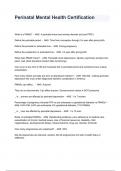Perinatal
Mental
Health
Certification
What
is
a
PMAD?
-
ANS
A
perinatal
mood
and
anxiety
disorder
(not
just
PPD!)
Define
the
perinatal
period.
-
ANS
Time
from
conception
through
1st
year
after
giving
birth.
Define
the
prenatal
or
antenatal
time
-
ANS
During
pregnancy
Define
the
postpartum
or
postnatal
time
-
ANS
1st
year
after
giving
birth
What
does
PMAD
mean?
-
ANS
Perinatal
mood
(depression,
bipolar,
psychosis)
anxiety
(ocd,
panic,
had,
ptsd)
disorders
(impact
daily
functioning).
Can
occur
at
any
time
in
life
but
increased
risk
in
perinatal
period
and
symptoms
have
unique
presentation.
How
many
infants
annually
are
born
to
depressed
mothers?
-
ANS
400,000...making
perinatal
depression
the
most
under
diagnosed
obstetric
complication
in
America
PMADs
can
affect...
-
ANS
Anyone!
They
do
not
discriminate.
Can
affect
anyone.
Socioeconomic
status
is
NOT
protective
_
in
_
women
are
affected
by
perinatal
depression
-
ANS
1
in
7
women
Percentage
of
pregnancy
induced
HTN
vs
pre-eclampsia
vs
gestational
diabetes
vs
PMADs?
-
ANS
6-8%
PIH,
6-8%
pre-eclampsia,
6%
gestational
diabetes,
21%
PMADs
_
in
_
men
are
affected
by
perinatal
depression
-
ANS
1
in
10
men
Risks
of
untreated
PMADs
-
ANS
Relationship
problems,
poor
adherence
to
medical
care,
exacerbation
of
chronic
medical
issues,
loss
of
financial
resources,
disability,
child
neglect/abuse,
developmental
delays,
tobacco/alcohol,
drug
use,
Suicide,
homicide
How
many
pregnancies
are
unplanned?
-
ANS
50%
Not
all
pregnancies
are
planned,
wanted.
Not
all
pregnancies
end
with
a
health
baby
or
fulfillment. Etiology
of
PPD?
-
ANS
Genetic
predisposition,
biological
sensitivity
to
hormonal
changes,
social/environmental
(Hx
of
trauma
or
poor
social
support),
psychological
(relationship
with
own
mom,
self
image/perfectionism)
Cultural
considerations
of
ppd
-
ANS
-in
some
cultures
mothers
may
not
feel
safe
to
express
needs
or
seek
help.
-may
report
symptoms
differently
based
on
culture
What
did
the
landmark
study
on
PPD
show?
-
ANS
22%
of
women
had
depression
during
first
year
postpartum:
26%
started
before
pregnancy,
33%
during
pregnancy,
40%
during
postpartum
Of
the
22%
of
postpartum
mothers
-
ANS
68%
had
unipolar
depression
66%
had
MDD
or
combo
with
GAD
22%
bipolar
depression
19%
had
thoughts
of
harming
selves
Prenatal
depression
relapse
rate
with
meds
and
without
meds
-
ANS
26%
who
continued
meds
relapsed
during
pregnancy
while
68%
who
stopped
meds
relapsed
Higher
relapse
rate
if
you
DC
meds
Percent
of
fathers
with
PPD?
-
ANS
10%
Depression
in
men:
timing,
symptoms
-
ANS
Peaks
at
3-6
months
postpartum
May
not
be
sad
"masked"
and
irritable,
aggressive,
hostile,
acting
out,
checked
out,
distractions
Do
men
seek
help
for
their
depression?
-
ANS
Not
often.
Only
3%
sought
help.
Men
are
likely
to
under
report
symptoms
Single
mothers
vs
single
fathers
-
ANS
Single
mothers:
higher
risk
of
maltreatment.
Twice
as
likely
than
mothers
with
partners
to
have
depression.
Single
fathers:
have
3
times
mortality
rate
than
single
mothers
or
partnered
parents.
Trans
gestational
parents
-
ANS
Needs
research
to
determine
prevalence.
Baseline
depression
and
anxiety
higher
than
adult
average
already.
Other
people
at
risk
-
ANS
Non-gestational
parents
also
at
risk
for
PMADs. Pregnancy
VS
Depression
-
ANS
Pregnancy-tearful,
labor.
No
change
in
self
esteem.
Sleep
disrupted
due
to
bladder.
No
SI.
Tire
but
rest
restores,
appropriate
worry,
joy,
increase
appetite
Depression:
irritable,
gloom,
rage,
low
self
esteem/guilt.
Sleep
changes,
SI.
Fatigue
and
no
restoration
of
rest.
Anhedonia
Characteristics
of
baby
blues
-
ANS
60-80%
new
moms
affected
Due
to
hormone
fluctuation/sleep
deprivation
Lasts
2
days-2
weeks.
Peaks
3-5
d.
Symptoms
of
baby
blues
-
ANS
Tearfulness,
liability,
exhaustion
Predominately
happy,
self
esteem
unchanged
Unrelated
to
stress
or
prior
psych
history
Consider
timing,
onset,
severity,
duration,
chronicity
when
differentiation
between
PPD
and
baby
blues
Major
unipolar
depression
with
peripartum
onset
DSM
criteria
-
ANS
5
or
more
symptoms
present
for
at
least
2
weeks
Depressed
mood
most
of
day
Loss
of
interest/joy
Weight
change
or
appetite
disturbance
Sleep
disturbance
Psychomotor
agitation
Fatigue
Poor
focus
Worthless
feelings
Excessive
guilty
Recurrent
thoughts
of
death/suicide
perinatal
anxiety
disorders
-
ANS
Includes
GAD,
panic
GAD
DSM-5
Criteria
-
ANS
Excessive
worry
and
anxiety
(about
ones
own
and
babies
needs)
Difficulty
controlling
worry
Agitation,
irritable Restless,
feeling
on
edge
Poor
concentration
Fatigue,
sleep
disturbance
(insomnia)
Increased
somatic
symptoms-muscle
tension,
palpitations,
GI,
SOB
Prevalence
of
perinatal
anxiety
-
ANS
15%
Estimates
between
8-20%
Panic
disorder
dsm
criteria
-
ANS
Episodes
of
intense
fear
peaking
in
minutes
SOB,
chest
pain,
choking,
dizzy
Hot/cold
flash,
rapid
HR,
numbness
Restless,
agitation,
irritable
Excessive
fear/worry
Fear
of
going
crazy
or
another
attack
No
trigger
sometimes
3
greatest
fears
in
panic
disorder
-
ANS
Going
crazy,
death,
losing
control
Perinatal
OCD
-
ANS
Obsessions
defined
by
recurrent
and
persistent
thoughts,
urges,
impulses
that
are
intrusive
and
unwanted
and
cause
anxiety.
Compulsions
are
defined
by
repetitive
behaviors
that
the
individual
feels
driven
to
perform
in
response
to
the
obsession.
Behaviors
or
mental
acts
are
aimed
at
preventing
or
reducing
anxiety
or
distress.
Perinatal
women
how
many
times
greater
risk
for
ocd
than
general
population?
____%
had
ocd
onset
in
prenatal
period
-
ANS
1.5-2
times
increase
risk
32%
had
ocd
onset
in
perinatal
period
Perinatal
OCD
characteristics
-
ANS
Intrusive
repetitive
thoughts
usually
of
harm
coming
to
self
and
baby.
They
are
EGO
DYSTONIC-meaning
not
identifying
with
self.
Very
distressing.




